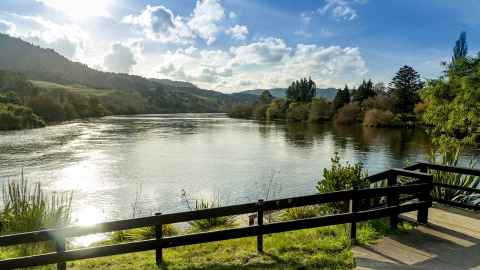Kaitiaki of the Waipā
25 November 2020
The Waipā River system is on the pathway to restoration, and making sure iwi involvement is embedded in every aspect of the process is critical to its success.

THE REVELATION that Māori grew taro at pā sites in the middle of the Waikato’s largest peat lake was one of many surprises for the School of Environment researchers delving into the history of the Waipā River as a case study in freshwater management.
Located 20 kilometres south of Hamilton, Lake Ngaroto’s polluted waters are in many ways symbolic of the degradation that began when European settlers drained the surrounding wetlands to make way for large scale farming.
“It’s going to be generations before it will be up to a quality that people will be able to safely use it again,” says Dr Meg Parsons, who jointly led a Marsden-funded research project with Associate Professor Karen Fisher into how Māori could have a greater voice through the establishment of co-governance and co-management arrangements.
“I do think that they provide a way forward that’s beneficial for all New Zealanders and for the environment,” says Karen, who believes that while the potential exists for iwi to have a powerful role in decision-making “it hasn’t quite played out as they would have hoped”.
A slippery slope
Unravelling the historic processes that led to the decline of the Waipā River system was critical to understanding the environmental changes, and the relationships with communities, that underpin contemporary initiatives to restore the waterways. “The key question was why is the Waipā River so degraded?” says Meg.
For Ngati Maniapoto, the Waipā was a ‘waterscape’ of connected rivers, lakes, streams and wetlands that had been occupied for 500 years and became a place of great prosperity with an abundance of food that was being exported before any significant European settlement.
However the Māori wars and subsequent invasion and confiscation of land brought with it a European view that the wetlands were unproductive and should be drained, against the wishes of iwi who saw them as a regulating mechanism in times of flooding.
Increased contamination and pollution of waterways, including run-off from dairy farming and discharges of raw sewerage from townships along the river, have added to the environmental injustices faced by iwi who have fought various issues through petitions to Parliament, legal action and claims for compensation from drainage boards.
Understanding the relationship between water and health is a key issue. Not only is human waste considered tapu, but Māori believe that contaminants diminish the life force of the river – as evidenced by a huge decline in fish numbers and increased health issues which local authorities have preferred to blame on poor hygiene standards rather than exposure to contaminated water supplies.
As kaitiaki (guardians) of the Waipā, Meg says that Ngati Maniapoto have historically struggled to get their voices heard – and their values recognised. Lawyers and judges often misinterpret kaitiakitanga because they see it from a very Euro-centric perspective, and she says that local authorities have “consistently refused to take action” well into the present century to address ongoing complaints about sewage discharges.
It’s against that context that current cogovernance and co-management arrangements are now playing out and, perhaps not surprisingly, Karen says that “everyone is still figuring out how to make it work”.

Breaking new ground
Established in 2010, the Waikato River Authority (WRA) was created as a Crown-Iwi organisation to oversee Te Ture Whaimana o Te Awa Waikato (Vision and Strategy) for the improved health and wellbeing of the Waikato and Waipā Rivers.
However the linkage between the Waikato- Tainui and Ngati Maniapoto treaty settlements as they relate to both rivers is complex. While there is a lot of ‘sign-posting’ between the legislation, there are also differences in terms of how Waikato-Tainui view their river as an ‘ancestor’ whereas Ngati Maniapoto view the personification of the Waipā as the taniwha, Waiwaia.
Nevertheless, Karen says the legislation recognises the special relationship that each iwi has to their respective rivers and “this is an assertion by Māori of their desire to be actively involved in decision making over the Waikato and Waipā Rivers”.
But while Ngati Maniapoto have representation on the WRA, Karen says that “doesn’t necessarily trickle down to the flax roots level”. For instance, there’s frustration that iwi management plans simply become part of a box-ticking exercise for councils dealing with multiple interests and iwi “feel like they’re just another stakeholder rather than a joint management partner”.
“I do think that they provide a way forward that’s beneficial for all New Zealanders and for the environment.”
Interpretation of the legislation is an ongoing issue, and Meg says that iwi are constantly having to educate officials and consultants about the meaning of concepts such as Mātauranga Māori (Māori knowledge). According to Meg, “institutional practices are limiting the effectiveness of these co-governance and co-management arrangements”.
While there is goodwill and good intentions, Karen says the reality is that iwi involvement is prescribed by a single piece of legislation and “they are being forced to operate within a colonial structure that doesn’t necessarily afford them the kinds of rights that they might have had if there was no colonial structure in place”.
Maintaining the status quo also extends to restoration work. “There’s a reluctance to actually think about new ways of doing things,” says Meg, pointing to the focus on building bigger and better stop banks and pumping stations as flood defences – rather than planting native trees and restoring wetlands which act as sinks to absorb water.
Limitations on funding for restoration is another sore point. The annual Treaty funding round is contestable and that creates tensions between iwi who are forced to compete for settlement money that they believe is theirs.
Added to that says Karen, is the focus on major projects like sediment control versus smaller projects that might be about cultural identity. “Measuring sediment isn’t something that’s going to enable a taniwha necessarily to thrive.”

Making progress
However there are many positives, including the creation of a Cultural Assessment Framework to help kaitiaki better understand the environmental issues facing Maniapoto marae and whānau.
Jointly developed by the Maniapoto Māori Trust Board and NIWA, the initiative will develop new ways to assess the health of the Waipā River and incorporate Mātauranga Māori into restoration efforts.
Being involved in restoration work such as tree planting has also been an important part of a healing process for the ecosystem and for those tangata whenua (people of the land) who were displaced by colonisation and have possibly lost touch with their iwi.
“Through being involved in these sort of restoration projects they’ve started learning the language” says Meg, “they’ve started learning about their whakapapa and re-establishing their relationships with each other as well as their river.”
For Karen, being Maniapoto has made it a very personal journey that stretches back eleven years to her very first hui in 2009 to discuss the future of the Waipā River. As her current research nears completion, the big question is what happens next? “What I’m taking from the research is a much better understanding of the complexity of what post-settlement reality looks like and the challenges that are confronting different groups.”
The three-year project will culminate in a book, co-authored by doctoral candidate Roa Crease and published by Palgrave MacMillan toward the end of 2020. Entitled Decolonising Blue Spaces in the Anthropocene, it will be a milestone for the research team, but – for Ngati Maniapoto – Karen says the challenge remains “how can we make this better?”

inSCight
This article appears in the December 2020 edition of inSCight, the print magazine for Faculty of Science alumni. View more articles from inSCight.
Contact inSCight.